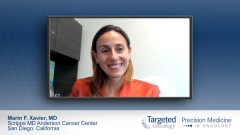
DLBCL: Frontline Therapy for GCB and ABC Subtypes
A discussion of standard frontline treatment approaches and considerations for utilizing maintenance therapy for patients with germinal center B-cell and activated B-cell subtypes of diffuse large B-cell lymphoma.
Episodes in this series

Marin F. Xavier, MD: For your practice, do you do anything different for germinal center vs activated B-cell [ABC] types in the frontline setting?
John M. Burke, MD: I don’t. A number of attempts have been made to develop drugs that might be specific for 1 type vs the other, particularly for the activated B-cell subtype. In general, those have not succeeded in clearly identifying an improved regimen or a regimen that should be used differently between the 2 subtypes.
There’s a trial going on specifically for the activated B-cell subtype, trying to build on the results of the PHOENIX trial, where ibrutinib seemed to improve outcomes in the relatively young subgroup with ABC subtype determined by gene expression profiling. There’s an ongoing international trial looking at acalabrutinib in that subgroup. No trial has clearly demonstrated improvement in 1 subtype vs the other, so I don’t change my therapy. It’s R-CHOP [rituximab, cyclophosphamide, hydroxydaunorubicin hydrochloride, vincristine, prednisone] for everybody. How about you?
Marin F. Xavier, MD: There are always these little signals. The lenalidomide looked like a promising combination that didn’t fully pan out to make it into real practice. Then we heard some new releases about the POLARIX trial or polatuzumab vedotin pulled up to the frontline setting, which looked interesting but isn’t FDA approved for frontline combination. Any thoughts on that?
John M. Burke, MD: We have the press release available that it met its primary end point of improving progression-free survival [PFS], the polatuzumab vedotin–R-CHP [rituximab, cyclophosphamide, hydroxydaunorubicin hydrochloride, prednisone] regimen as compared with R-CHOP [rituximab, cyclophosphamide, hydroxydaunorubicin hydrochloride, vincristine, prednisone]. That was an all-comers study, not broken down by cell-of-origin subtype. It will be exciting to see those data and see what the community makes of it.
Marin F. Xavier, MD: We discussed most of the landscape for frontline therapy. Our practice is very similar.
John M. Burke, MD: What testing do you order for a new patient with large cell lymphoma?
Marin F. Xavier, MD: I saw 1 in clinic and 1 in the hospital, so it depends on the type of presentation. Everybody gets standard staging with bone marrow biopsy and aspiration, cross-sectional imaging with a PET [positron emission tomography]–CT scan ideally, and HIV testing, hepatitides testing pre-rituximab. You have to have central venous access. The work-up is pretty standard across the board. Now, if they’re having CNS [central nervous system] symptoms, then diagnostic and prophylactic lumbar punctures with intrathecal chemotherapy can be introduced. I practice in a large metropolitan hospital [Scripps MD Anderson Cancer Center] with a lot of HIV patients, and the practice is different. Everybody who has HIV needs lumbar puncture with diagnostic and, if negative, prophylactic intrathecal chemotherapy with their R-EPOCH [rituximab, etoposide, prednisone, vincristine, cyclophosphamide, hydroxydaunorubicin hydrochloride]. That’s a pretty standard work-up.
Of course, the WHO [World Health Organization] criteria morphed over the years, and now it’s more high-grade lymphoma and then a FISH [fluorescence in situ hybridization] panel for BCL2, BCL6, and MYK. There’s a bit of uncertainly in what to do with overexpressers like double expressers or triple expressers, but the double-triple hits are high-risk patients.
John M. Burke, MD: My work-up is pretty similar. The only thing I heard that I might do a little differently is I try to selectively do the bone marrow biopsies. For example, if somebody has no evidence of marrow involvement on a PET scan or normal blood counts, I’ve taken to skipping the bone marrow biopsy on those folks. If they do have some suggestion of bone involvement or abnormal blood counts, I’ll do a bone marrow on those. Then if they’re going on clinical trials, a lot of the trials still mandate the bone marrow biopsies.
Marin F. Xavier, MD: Actually, I also skip it if they have diffuse bony lesions. So I skip it for a different reason. If we know they have cytopenias and severe bone disease, it’s not going to change anything because they have high-risk disease. That’s very brave. I try to do the complete staging for Hodgkin disease, so I try to skip it if I can. There’s another question about maintenance therapy. Dr Burke, does your practice support maintenance therapy for frontline large cell lymphoma?
John M. Burke, MD: No, I’ve never used maintenance in large cell lymphoma. If any study were to affect practice for me, it would be REMARC. That was a study of maintenance lenalidomide after R-CHOP [rituximab, cyclophosphamide, hydroxydaunorubicin hydrochloride, vincristine, prednisone] that demonstrated improved progression-free survival but not improved overall survival. I haven’t taken to using it in my practice. It was deemed a negative study, and it did not get regulatory approval. Because of the added cost, toxicities, and lack of a survival advantage, it’s not something that I’ve used personally. How about you?
Marin F. Xavier, MD: The short answer is no. I’ll confess that there has been an occasional transformed patient who I’ve done maintenance therapy on if their disease was particularly aggressive. Delaying and improving their remission, at least from their low-grade component, may be clinically useful. During the pandemic, any elective rituximab has been discontinued in most situations but not for large cell lymphoma. I’ve never done maintenance for rituximab or lenalidomide for that matter.Those are some interesting data out there: PFS for maintenance.
Transcript edited for clarity.







































